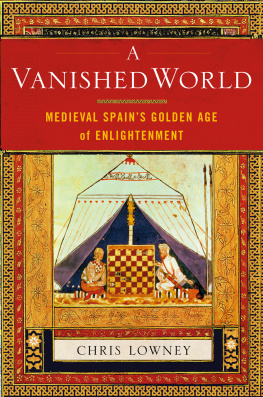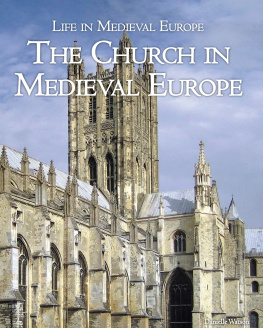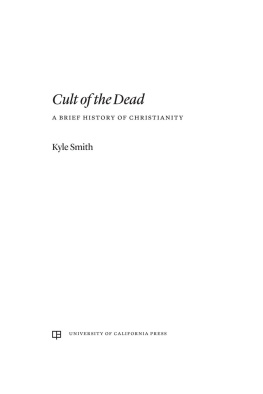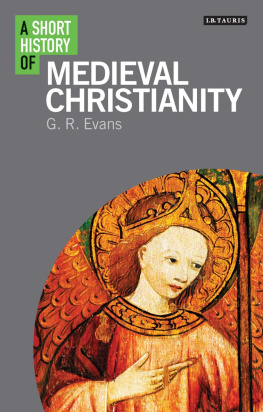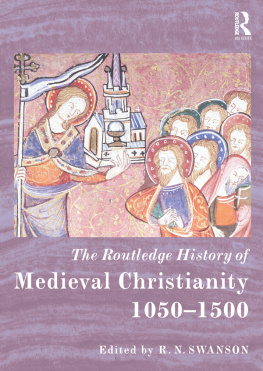Medieval Christianity
Medieval Christianity
A NEW HISTORY
KEVIN MADIGAN
Yale UNIVERSITY PRESS
New Haven and London
Published with assistance from the foundation established in memory of Calvin Chapin of the Class of 1788, Yale College.
Copyright 2015 by Yale University.
All rights reserved.
This book may not be reproduced, in whole or in part, including illustrations, in any form (beyond that copying permitted by Sections 107 and 108 of the U.S. Copyright Law and except by reviewers for the public press), without written permission from the publishers.
Yale University Press books may be purchased in quantity for educational, business, or promotional use. For information, please e-mail (U.K. office).
Maps by Bill Nelson.
Set in Galliard type by Newgen North America, Austin, TX.
Printed in the United States of America.
Library of Congress Cataloging-in-Publication Data
Madigan, Kevin, 1960
Medieval Christianity : a new history / Kevin Madigan.
pages cm
Includes bibliographical references and index.
ISBN 978-0-300-15872-4 (hardback)
1. Church historyPrimitive and early church, ca. 30600. 2. Church historyMiddle Ages, 6001500. I. Title.
BR162.3.M33 2014
270.3dc23
2014021498
A catalogue record for this book is available from the British Library.
This paper meets the requirements of ANSI/NISO Z39.48-1992 (Permanence of Paper).
10 9 8 7 6 5 4 3 2 1
To my students
Discipulis meis eximiis
Contents
Illustrations
Maps and Plans
By the early seventh century or so, the biblical culture today called medieval Christianity was the distinguishing and unitive religious and cultural mortar of European society. By the year 1000, six or seven monarchies, countless city-states, duchies, counties, and ecclesiastical fiefdoms organized the European land mass politically and geographically. By that time, the major ethnic groups of Europe (Celtic, Germanic, Roman, and Slavic) would all be settled and Christianized. Within the midst of this considerable political, ethnic, and linguistic mix, one tradition united the continent religiously and to some extent politically, socially, and economically: Christianity. Indeed, the church was the single institution that cut across the lives, political boundaries, and ethnic divisions that otherwise made local traditions and customs so strong a factor in early medieval Europe. One can go so far as to assert, as has the great British historian R. W. Southern, that the church was identical with medieval society and that it was this identity that distinguished it from societies that preceded and succeeded it. As Southern has also observed, the medieval church was a compulsory society in exactly the same way that the modern state is an unavoidably obligatory society. Our modern states require us to pay taxes for defense and public services, to obey their laws, and to subordinate our private desires to the good of the commonweal. Just so, baptism into medieval society required one to do all these things for the church. As Southern also observes, the medieval church was also very much like a modern state insofar as it collected taxes, administered justice in accordance with its laws, and had the power of life and death over its citizens. It had a coercive power in the pope (coercion being expressed most usually through excommunication or the threat of it) and a purpose to its government: to direct man into a single Christian path. Only the lack of a dependable army causes the analogy to break down.
The church not only formed the institutional framework within which one lived out ones life. Every important event for the individual from birth to death (including, from the ninth century, marriage) was marked by ecclesiastical ritual. The same set of sacraments (set at seven in the late twelfth century) punctuated the lives of Christians in northern England and Iceland, southern Italy, western Spain, and Poland. Monasteries, churches, chapels, parish churches, convents, cathedrals, and simple stone crosses covered the landscapeall professing or representing the same creed. Clergypriests, bishops, deaconswere everywhere, as were monks, nuns, and other religious. More or less the same liturgy of the Mass was celebrated in the same language across the Continent. Certainly, there were outsiders in this cultureprincipally Jewish communities and sects of hereticsbut they were minorities in every sense of that modern word. This culture was held together by religious belief expressed in ancient creeds whose authority very few challenged or from which they dissented. Very few would have doubted the existence of a triune God who had sent his Son, both human and divine, to redeem humankind and to set the normative and salvific pattern for human life. Nor would many have doubted that life on this earth was a journey, or pilgrimage, to a domain more real, more permanentindeed eternalto be spent in everlasting beatitude with God or never-ending punishment.
A tremendous force for the unity of Christendom and for the possibility of a shared biblical culture was the possession of a common sacred language, Latin, which the church had inherited from Rome. This was a language used in all matters of religious culture, including secular diplomacy and politics. (The word secular is put in quotation marks, as medieval people did not distinguish, as we do in modern Western societies, between the sacred and the secular.) Western theological literature and art are saturated in imagery and idioms taken from the Latin Bible. The Christian liturgy was conducted in Latin, as were creeds, one of the major media for instruction in the rudiments of faith in all centuries of the Middle Ages (though only clerics would have known the Latin in some times and places, as most lay Christians were not Latinate). It was also the language in schools and, eventually, in universities.
In his pathbreaking analysis of the making of Europe in the central Middle Ages, historian Robert Bartlett has painstakingly charted the outward establishment of bishoprics, especially in the Baltic region, as Latin Europe expanded eastward and northward. He observes that in the process of expansion, new peripheries came to resemble the old center of Europe. It would not be going too far to say that something like a homogeneous culture emerged in the central Middle Ages. This culture had many shared elements, including shared military technology, agricultural practices and instruments, and the configuration of villages and towns. Yet it was a culture that also shared a common religious view of the cosmos, widespread religious beliefs, and shared religious practices. These, too, were essential to establishing a common European culture. It is on the establishment and evolution of this religious culture from ca. 500 to 1500 that I will focus in this book.
Many existing textbooks have laid out this very general picture of the Middle Ages. As is the case with most medievalists, textbooks on medieval ecclesiastical history are causing my bookshelves to groan. I have learned a vast amount from these volumes. Indeed, I owe their authors a profound debt of gratitude. The best of these textbooks are not merely works of synthesis (though synthesizing the scholarship on a millennium of history is no contemptible feat), but are also scholarly works in themselves, books that made us see the medieval church in new ways. I think, for example, of R. W. Southerns 1970 volume, Western Society and the Church in the Middle Ages. Southerns textbook brilliantly analyzed central figures, movements, and individuals, as well as relations with the Eastern church, in the high and late Middle Ages.
So why a new textbook? My hope in composing this volume was to synthesize the important new scholarly developments in the field of medieval Christianity in the four decades since the publication of Southerns book and to integrate them with some traditional themes and topics in medieval Christianity. I have attempted to write a narrative account of the Middle Ages without sacrificing analytical rigor or explanatory power, one that takes advantage of the many virtues of literature published in this field since the publication of Southerns textbook. For that reason, I have spent time in almost all chapters talking about the stories of real human beings and their lives, not merely because of the intrinsic interest of their stories, but also because of the illustrative power of their lives.
Next page


